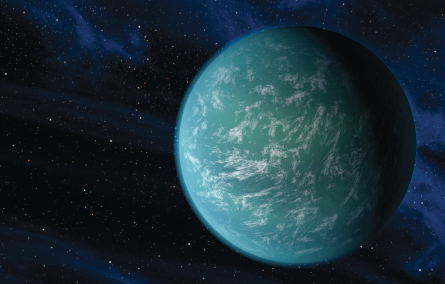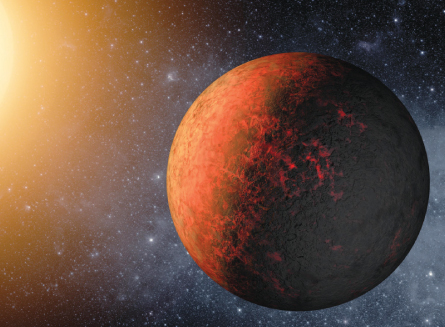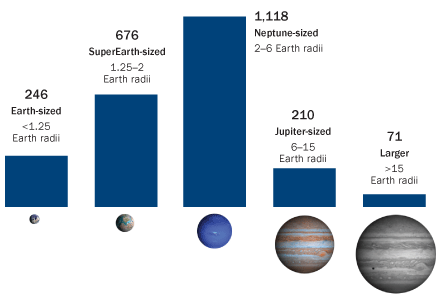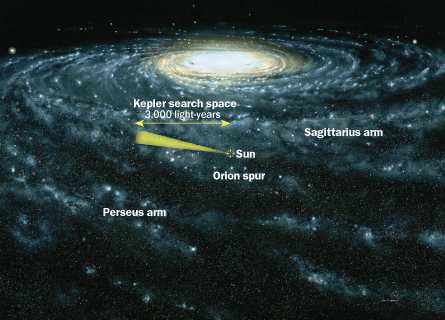Planetary Peekaboo
Astronomers aren’t playing games when it comes to spotting an exoEarth
ANCHORAGE, Alaska — On a bright June evening, residents of Anchorage packed the theater in Cyrano’s Off-Center Playhouse, ready to sample some otherworldly dispatches.




The messages were beamed to Earth by NASA’s Kepler spacecraft, which circles the sun spying on planets orbiting distant stars. Planet-hunting members of the mission’s science team, in town for an American Astronomical Society meeting, served as translators for the evening, telling tales of far-off worlds that put a twinkle in the spacecraft’s eye.
At the time of the summer get-together, the Kepler team had officially confirmed the existence of 72 exoplanets, a tally that stumped some audience members during a game of science trivia.
“When I first wrote this question, the answer was 61,” said Anchorage resident Wendy Withrow, the event’s emcee. “And it wasn’t that long ago.”
The Kepler craft is delivering results at an extraordinary rate, with a stable of planetary candidates that now tops 3,000. At times, every week seems to herald the confirmation of a new world, another planet joining a cosmic menagerie that includes molten spheres, two-starred orbs and siblings snuggled so close together that each occasionally rises in the other’s sky.
Since the June meeting, Kepler scientists have announced another five confirmations, upping the exoplanets on the confirmed list to 77. Soon, the team expects to pin down an additional 800 or so, which would double the total number of planets discovered by any search, ever.
With such vast returns, it’s hard to believe that Kepler’s goal — to make a major stride in determining how special Earth is — once balanced on the brink of impossibility. Until NASA granted the team a four-year extension in April, failure was almost certain. The stars in Kepler’s eye proved rowdier than expected, blinking and winking and muddying the signatures of orbiting planets.
“When Kepler was launched, the objective was to determine the frequency of Earth-sized planets in the habitable zone. We actually changed that statement as the years evolved; we dropped ‘in the habitable zone,’ ” says Natalie Batalha of San José State University in California. “Now we’re adding that back in.”
Barring any more unexpected malfunctions (SN Online: 8/14/12), the team is in business through September 2016. And researchers are working to clear the hurdles standing in the way of quantifying exoEarths — small planets living in life-friendly zones around their stars.
Reaching the finish line will still be a rocky journey. The scientists have to improve their detection techniques to better pick possible exoplanets from among the thousands of blinking lights spilling from the Kepler field of view. Researchers are also working on tools to characterize planets once they are confirmed: Are they rocky, like Earth? Ultimately, the team might actually figure out how frequently Earths spangle the skies viewed by Kepler, but whether that number will apply to the entire galaxy is not so clear.
“Are there other habitable planets out there, and how common are they?” asks Geoff Marcy of the University of California, Berkeley. “This is a really profoundly beautiful question. It’s one of those questions that transcends science. It’s in the realm of philosophy.”
Winning the lottery
Kepler finds Earthly cousins by engaging in a staring contest with a patch of sky stuffed with more than 150,000 stars. The spacecraft watches for blinks occurring when a planet dims a star’s light by passing in front of it, or transiting. A planet in an Earthlike orbit would dim its star just once each Earth year — and scientists look for multiple dimming events, requiring years of observing time.
“We can’t look away, because we might miss one of the transits,” Nick Gautier of the Jet Propulsion Laboratory in Pasadena, Calif., told the audience at Cyrano’s.
Sighting the blinking kicks off a complex process meant to distinguish a real-deal planet-bearing star from a star just showing off its inherent twinkles. But Kepler’s star field is overly rambunctious, with natural brightness fluctuations much greater than expected for stars like the sun, says Jon Jenkins of the SETI Institute in Mountain View, Calif. “It was a big surprise to us that the typical solarlike star is noisier than the sun,” says Jenkins, Kepler’s lead analytical guru. “The sun really isn’t a ‘solarlike star.’ ”
This new finding makes pegging a signal as a candidate planet much more difficult, so Jenkins and about two dozen other team members are working on improvements that will filter out excess stellar noise. To do this, the team is fine-tuning its computer software, teaching the software to be a bit more discriminating in what it lets through.
Jenkins likens the tuning process to selectively listening to the tenor in a barbershop quartet. “As long as you’re listening to the tenor, you can screen out the bass and the baritone because they don’t interfere,” he says. But you also have to make the system’s ear more sensitive by removing barriers that can introduce the equivalent of static to the listening process.
“We’ve made significant progress, but we still have to continue to beat those down in order to be able to find the smallest planets that are of the most interest to us,” Jenkins says.
As the mission has progressed, scientists have found more and more small candidates. But there are worries those climbing numbers may come to a halt.
At the astronomy meeting, scientists presented preliminary analyses of the candidate census so far. Hot Jupiters — large planets closely orbiting a parent star — are often found by themselves and are scarce in the Kepler field, probably because they don’t much care to live around the type of star Kepler looks at. Smaller planets don’t appear to be as picky: There’s a whole load of planets bigger than Earth but smaller than Neptune, and they live around a variety of types of stars. An additional report pointed to roughly a dozen candidates smaller than Mars awaiting confirmation.
Scientists have long assumed that smaller planets are more abundant than larger ones, but the current Kepler census suggests that the pattern might not hold in all cases. “We see the now-familiar rise in planet occurrence as you go to smaller planet sizes, down to two Earth radii,” said Andrew Howard of the University of Hawaii at Manoa. “And then something interesting happens: The occurrence actually falls.”
No one knows why — or whether the falloff is real. “One possibility is that we’re seeing something profound about planetary science,” Howard said. The other: Kepler’s current trove isn’t representative of what is actually out there — either because of the stars themselves, or because listening techniques are biased toward bulked-up basses.
If the number of Earth-sized planets does drop off, scientists will have to work even harder to find them. Already, two of these exo-treasures have rolled off the Kepler pipeline: Kepler-20e and Kepler-20f, announced in December. But these planets sit too close to their parent star for liquid water and life to survive.
Other planets, Kepler-22b announced last December (SN Online: 12/6/11) and one orbiting the binary star system Kepler-47 reported in Science in August, sit in their stars’ habitable zones but are too big to qualify as Earth-sized.
Planet ingredients
Though spying Earth-sized planets in habitable zones fulfills Kepler’s goals, it won’t be enough to convince scientists that they have found a true Earth 2.0. Kepler can determine only the radius of a planet, so the team needs a different way to measure a planet’s mass — and thus its density and composition.
Traditionally, a star’s wobble has been used to measure mass, in what’s known as the radial velocity method. Marcy presented preliminary data at the astronomy meeting suggesting that planets begin to transition from bloated, watery mini-Neptunes to rocky Earths when they are somewhat smaller than two Earths. But he hasn’t surveyed enough planets to know for sure.
Since smaller planets tug less on a parent star, measuring the star’s wobbles requires a supersensitive, stable instrument. “The U.S. currently doesn’t have one,” says Marcy, who performs radial velocity follow-up measurements on the planets for which it is possible. “It’s a huge embarrassment.”
Instead of traditional radial velocity follow-ups, a newer method called transit timing variations might help scientists calculate the mass of a small planet. For this method to work, a transiting Earth-sized planet in a system with at least one Neptune-like sibling is “a golden combination,” Marcy says. Even without transiting its parent star, a larger planet would cause slight variations in the smaller planet’s transit times. These variations would allow astronomers to measure the larger planet’s mass, from which they could calculate the smaller planet’s mass.
“A very small handful of people are doing this, and they’re in very high demand right now,” Batalha says, adding that characterizing planets needs to become a priority.
“Can you have an Earth-sized planet that’s like a big cotton ball? Maybe you could. Are they all rocky planets like Earth? They might be icy, dirty snowballs,” she says. “We’re in this candy store with all these planets, and it would make me very sad if we didn’t have the technology to characterize them.”
To Earth and beyond
Despite the obstacles still to be overcome, scientists think they’re close to achieving their goal. “We’re going to know, within two years, the following thing: Whether Earth-sized planets are common or rare, in Earthlike orbits,” Marcy says.
Of course, the broader implications of the Earthy frequency determined by Kepler will depend on how well the census reflects the galaxy as a whole. Because the telescope stares at stars that hover above the Milky Way’s plane, it’s unlikely that the patch will be representative of real estate nearer the galactic bulge, for example. Still, the Kepler patch is “supposedly like the solar neighborhood,” says Jack Lissauer of NASA’s Ames Research Center in Mountain View, Calif.
Though a destination in itself, finding the frequency of Earthy worlds is just one part of a much broader, millennia-old question: Are we alone, or is there other life in the universe? Ultimately, scientists want to profile exoEarths, however common they may be, by studying atmospheres, sniffing around for potential biosignatures and searching for signs of intelligent life.
The Kepler mission is just the start of that journey. Step by step, the team is leaping over the hurdles that come with plunging into the unknown, and managing to turn up surprises along the way. As the evening wound down at Cyrano’s, Anchorage resident Todd Sherwood offered his opinion of the Kepler team’s work: “It’s like close encounters of the 12th kind.”







